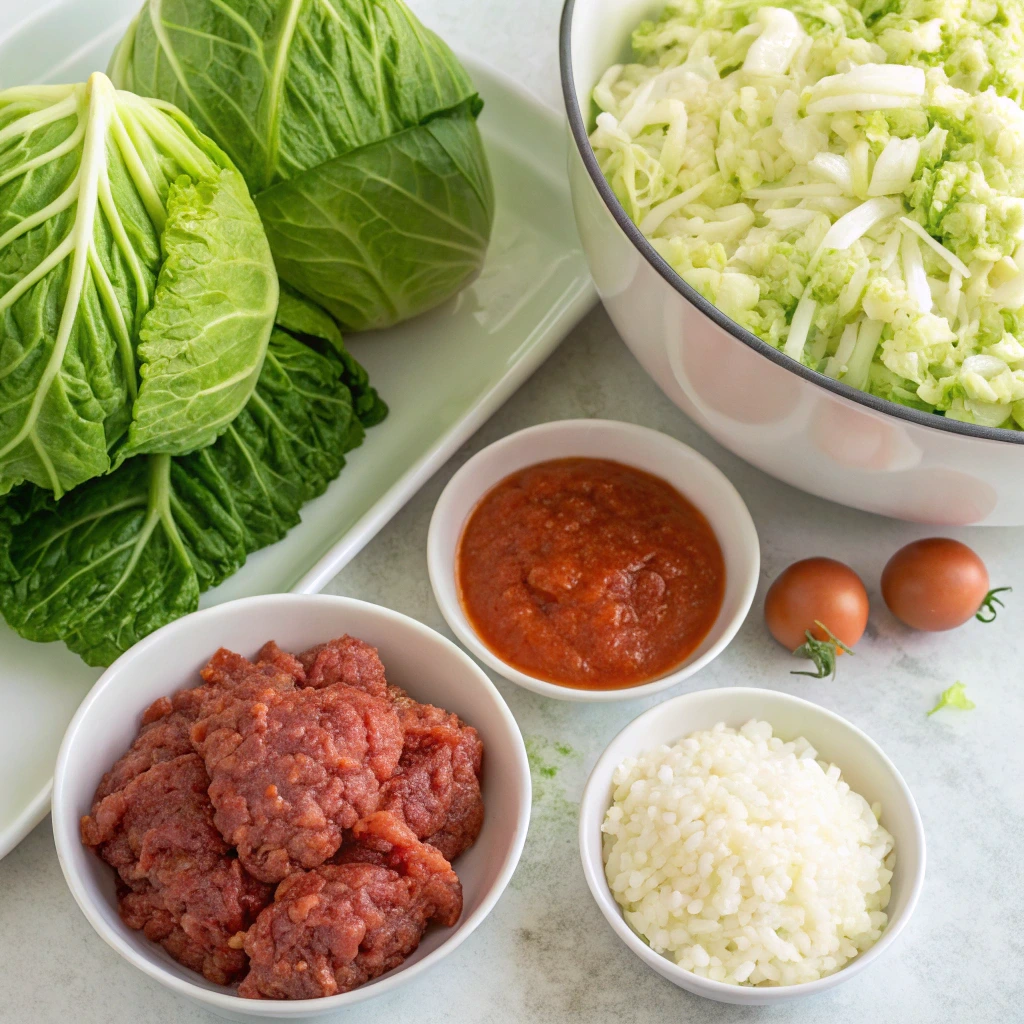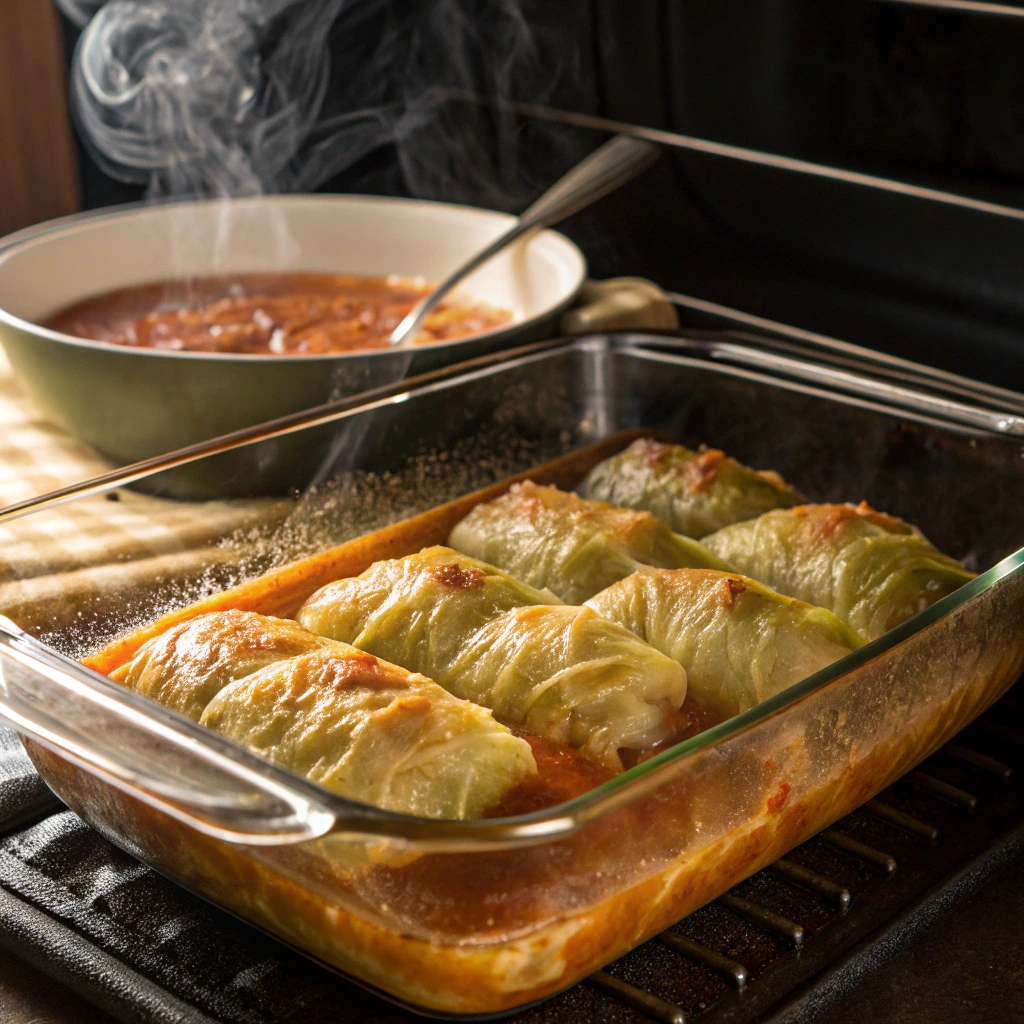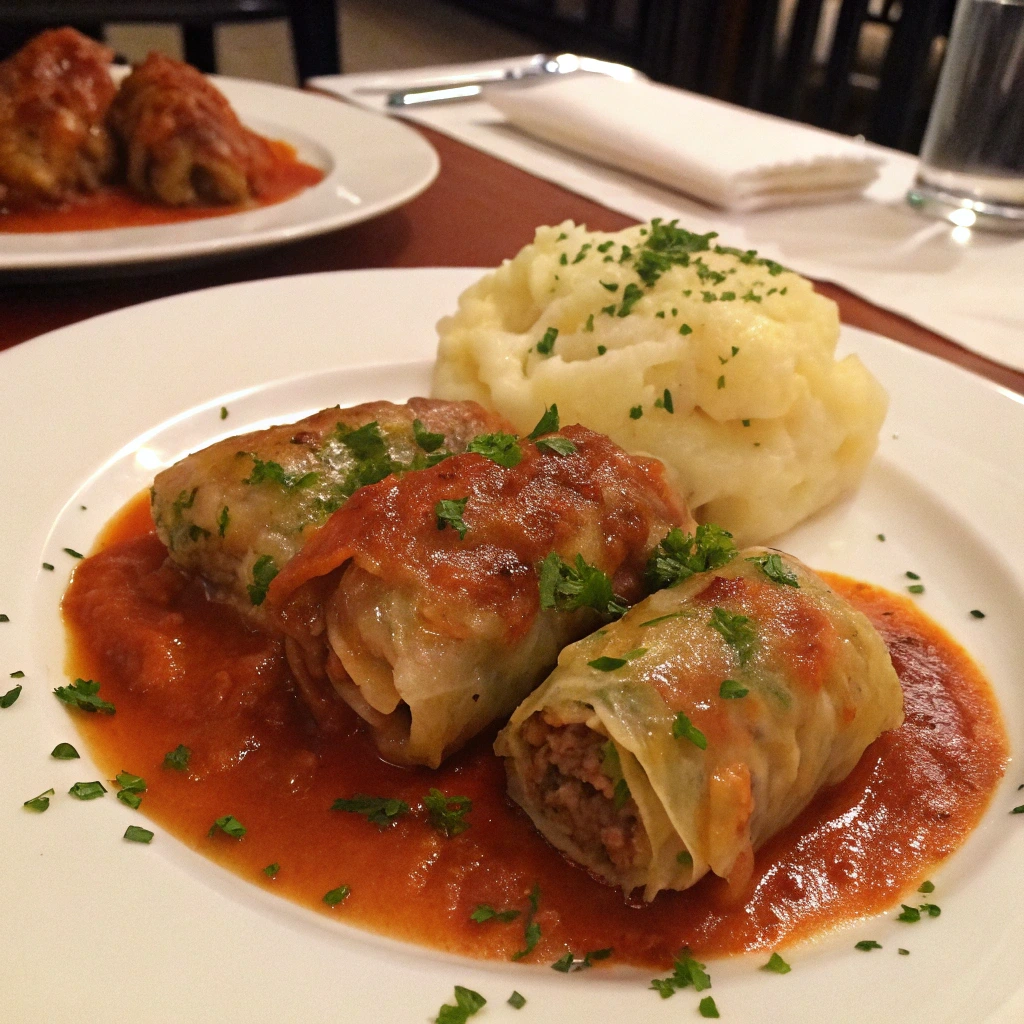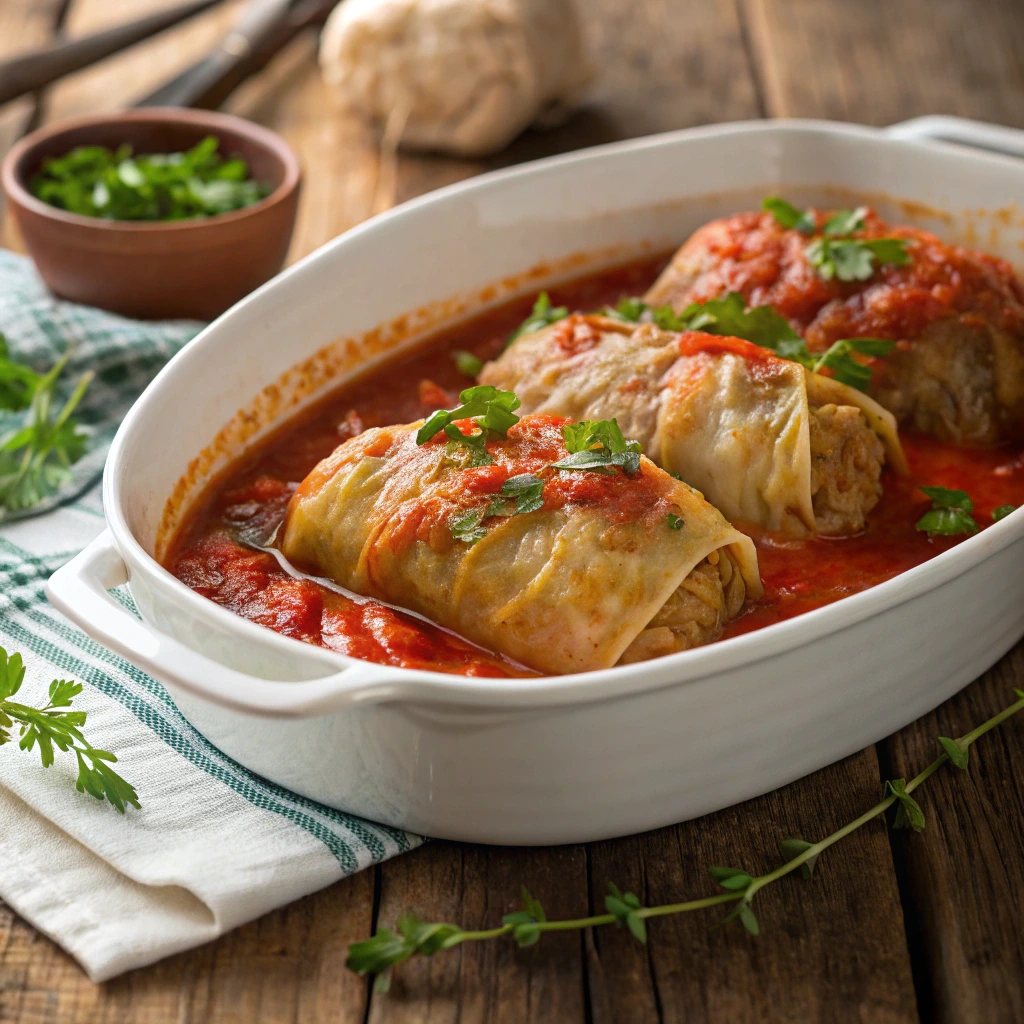Stuffed Cabbage Rolls Recipet is more than just a comforting dish—it’s a beloved classic passed down through generations. With its hearty mix of ground meat and rice, all wrapped in tender cabbage leaves and smothered in rich tomato sauce, this recipe delivers bold flavor and old-world charm in every bite.
Across cultures and cuisines, stuffed cabbage rolls have earned their place at dinner tables for centuries. From Polish gołąbki to Middle Eastern malfouf, each version brings its own twist—but the soul of the dish remains the same: humble, wholesome ingredients turned into something special.
Table of Contents
PART 1: Origins and Cultural History of Stuffed Cabbage Rolls Recipet
– Where Stuffed Cabbage Rolls Came From: A Global Snapshot
The origins of Stuffed Cabbage Rolls Recipet span across centuries and continents. While it’s often associated with Eastern European cuisine, versions of stuffed cabbage appear in cultures as far-reaching as the Middle East, Asia, and the Mediterranean. These humble, hearty rolls emerged as a practical way to make the most of simple ingredients—meat, rice, and cabbage—and stretch them into satisfying, nourishing meals for families.
In Poland, they’re known as gołąbki, which means “little pigeons,” a reference to the shape of the rolled cabbage. In Hungary, you’ll hear them called töltött káposzta, while in Russia they’re called golubtsy. Middle Eastern versions, such as malfouf, often use lamb, lentils, and a mix of warm spices wrapped in more delicate cabbage leaves.
Despite the variations, the core idea remains the same: cabbage leaves wrapped around a hearty filling, simmered or baked in a tomato-based sauce. This recipe reflects both cultural identity and economical cooking—two things that make it an enduring favorite.
– Traditional Variations from Poland, Hungary, and the Middle East
Each culture puts its own unique spin on the classic Stuffed Cabbage Rolls Recipet, making the dish endlessly versatile:
| Country/Region | Local Name | Common Ingredients | Cooking Style |
|---|---|---|---|
| Poland | Gołąbki | Ground pork/beef, rice, onions, tomato sauce | Baked or stovetop |
| Hungary | Töltött Káposzta | Pork, paprika, sauerkraut, tomato puree | Baked with sauerkraut |
| Russia | Golubtsy | Beef, rice, carrots, tomato paste | Stewed in sauce |
| Middle East | Malfouf | Ground lamb, pine nuts, allspice, lemon | Rolled tight, simmered |
| Jewish Cuisine | Holishkes | Beef, matzo meal or rice, sweet-tangy tomato | Holiday staple |
In many households, cabbage rolls aren’t just dinner—they’re tradition. They’re served during Christmas, Passover, weddings, and even funerals, reinforcing their deep connection to memory and meaning.
Stuffed cabbage continues to evolve as cooks around the world embrace its adaptability. Whether it’s with beef, lamb, or lentils—baked, braised, or simmered—it remains a recipe with both heritage and heart.
PART 2: Ingredients for the Perfect Stuffed Cabbage Rolls Recipet

– Best Cabbage Types for Rolling and Texture
The foundation of a great Stuffed Cabbage Rolls Recipet starts with choosing the right cabbage. Not all cabbages roll the same, and the variety you pick will affect texture, flexibility, and overall taste.
| Cabbage Type | Benefits | Best Use |
|---|---|---|
| Green Cabbage | Widely available, flexible leaves | Traditional rolls |
| Savoy Cabbage | Tender, crinkly leaves, mild flavor | Elegant presentation, easy rolls |
| Napa Cabbage | Soft, Asian variety | Quick-cook or fusion-style rolls |
| Red Cabbage | Firm, colorful | Visual appeal, but tougher roll |
Green cabbage is the go-to for most traditional recipes. It holds its shape well when boiled or steamed and is easy to work with. Savoy cabbage, with its softer texture and more decorative look, is great if you want something a little more gourmet.
Before rolling, the cabbage must be softened. You can blanch the leaves in boiling water or freeze the head overnight, then thaw—it softens naturally, making peeling and folding easier.
– Choosing the Right Meat and Rice Combo
The filling is the soul of your stuffed cabbage. A classic Stuffed Cabbage Rolls Recipet uses a savory blend of ground beef and long-grain white rice, seasoned with garlic, onions, salt, and pepper. But there’s room to personalize:
Popular Meat Options:
- Ground beef – Traditional and hearty
- Sausage – Bold, spicy flavor
- Ground turkey or chicken – Leaner, lighter taste
- Lamb – Earthy, used in Middle Eastern versions
Rice Options:
- White rice – Classic choice
- Brown rice – Nutty, healthy alternative
- Cauliflower rice – Low-carb, keto-friendly
- Quinoa – Adds texture and protein for a modern twist
Combining beef and pork gives a balanced, flavorful roll with just the right amount of fat. For a vegetarian spin, lentils or mushrooms with rice make a satisfying filling that doesn’t sacrifice taste.
Don’t forget seasoning—onions, garlic, herbs, and even paprika or cumin can elevate your stuffing. Some families also mix in an egg to bind the filling for a firmer bite.
– Tomato Sauce Options: From Sweet to Tangy
No Stuffed Cabbage Rolls Recipet is complete without a generous blanket of tomato sauce. It’s not just for flavor—it keeps the rolls moist as they cook.
Here are popular sauce styles:
- Classic tomato sauce – Simple blend of tomato puree, onions, garlic
- Sweet and sour sauce – Tomato base with vinegar and a touch of sugar
- Spiced tomato sauce – Includes paprika, cumin, cinnamon for a Middle Eastern flavor
- Creamy tomato sauce – A dash of cream or sour cream adds richness
Homemade sauces are easy to make, but store-bought can work in a pinch—just enhance them with fresh herbs or garlic. Make enough to coat the rolls generously and to spoon over when serving.
PART 3: Step-by-Step Stuffed Cabbage Rolls Preparation Guide
– Prepping and Softening the Cabbage Leaves
Before you even think about rolling, you need to prep your cabbage the right way. Tough, stiff leaves will crack and tear, ruining your Stuffed Cabbage Rolls Recipet before you even hit the oven.
There are two trusted methods to soften cabbage leaves:
1. Boiling Method
- Remove the core of the cabbage using a sharp knife.
- Place the whole head in a pot of boiling water.
- As the outer leaves begin to soften, gently peel them off with tongs.
- Continue until you have 10–12 whole, pliable leaves.
2. Freezing Method
- Freeze the whole cabbage head overnight in a zip-top bag.
- Thaw it completely the next day at room temperature or in the fridge.
- The leaves will soften naturally and peel off easily, no boiling required.
Once softened, trim the thick stem at the base of each leaf to make rolling easier. Don’t slice all the way through—just shave it down to flatten the leaf without tearing it.
– How to Mix the Filling and Roll Like a Pro
Now comes the fun part—assembling your Stuffed Cabbage Rolls Recipet.
Basic Filling Recipe:
- 1 pound ground beef (or half beef, half pork)
- 1 cup cooked white rice
- 1 small onion, finely chopped
- 2 cloves garlic, minced
- 1 large egg (optional, helps bind)
- Salt and pepper to taste
- Optional: parsley, paprika, or crushed red pepper for heat
Mix the Filling:
- Combine all ingredients in a bowl.
- Mix gently with your hands or a spoon. Don’t overwork—it makes the filling tough.
Roll the Cabbage:
- Lay a cabbage leaf flat, with the trimmed stem end facing you.
- Spoon 2–3 tablespoons of filling near the base.
- Fold the sides over the filling, then roll from the stem end up—like a burrito.
- Place seam-side down in a baking dish or Dutch oven.
Repeat until all leaves are filled. If you have leftover filling, you can form small meatballs and nestle them among the rolls or freeze for later use.
Layering Tip: Line the bottom of the pan with extra cabbage leaves to prevent scorching and to add extra flavor.
Want an easy rolling trick? Wet your fingers with a bit of water or oil—it makes folding smoother and prevents sticking.
PART 4: Cooking Techniques for Stuffed Cabbage Rolls

– How Long Should Cabbage Rolls Bake? Oven Baking vs. Stovetop
One of the most frequently asked questions about Stuffed Cabbage Rolls Recipet is: How long should cabbage rolls bake? The answer depends on the method, but in general, you’ll want to give them plenty of slow heat so the cabbage becomes tender and the flavors meld.
Oven-Baked Method:
- Prep: Preheat oven to 350°F (175°C)
- Layer: Arrange the cabbage rolls seam-side down in a casserole dish or Dutch oven.
- Sauce: Pour enough tomato sauce over the rolls to fully coat them.
- Cover: Use a lid or foil to seal the pan.
- Bake Time: Bake for 1 hour 30 minutes to 2 hours.
The rolls should be bubbling and tender when done. You can uncover the pan for the last 15 minutes to let the top caramelize slightly.
Stovetop Simmering:
- Use a large pot with a heavy bottom.
- Add a layer of extra cabbage on the bottom.
- Stack rolls, cover with tomato sauce, and add a little water or broth to prevent sticking.
- Simmer covered over low heat for 1.5 to 2 hours.
– Slow Cooker and Instant Pot Variations
Looking for a hands-off way to cook your Stuffed Cabbage Rolls Recipet? Slow cookers and pressure cookers are a fantastic alternative.
Slow Cooker Version:
- Prep the rolls as usual.
- Spray the crockpot with nonstick spray or line with cabbage leaves.
- Stack the rolls, adding sauce between layers.
- Cook on low for 6 to 7 hours, or high for 3 to 4 hours.
Instant Pot Version:
- Use the sauté setting briefly to preheat.
- Layer the rolls and add 1–1.5 cups of sauce + ½ cup water.
- Seal and pressure cook on high for 18–20 minutes.
- Let the pressure naturally release for 10 minutes.
Pressure cooking delivers melt-in-your-mouth rolls in record time. Just be careful not to overfill the pot—the steam needs space to circulate.
PART 5: Storage, Freezing, and Reheating Tips
– How Long Can You Keep Uncooked Cabbage Rolls in the Fridge?
If you’re making your Stuffed Cabbage Rolls Recipet ahead of time, good news: uncooked cabbage rolls store well in the fridge. But food safety matters.
Storage Guidelines:
- Place the uncooked rolls in a single layer in an airtight container or wrap tightly with plastic wrap and foil.
- Store in the coldest part of your refrigerator (usually the back).
- Refrigeration Time: Up to 24 to 48 hours max before cooking.
Anything beyond that and the cabbage can get soggy, and the raw meat mixture becomes a safety concern. For longer storage, freezing is the better option.
Pro Tip: Don’t add the sauce until you’re ready to cook. It prevents the cabbage from getting mushy.
– Best Ways to Freeze and Reheat Without Losing Flavor
Stuffed Cabbage Rolls Recipet is incredibly freezer-friendly. Whether raw or cooked, the key is to prevent freezer burn and maintain the sauce’s moisture.
Freezing Cooked Rolls:
- Let them cool completely.
- Place individual rolls on a baking sheet and flash freeze for 1–2 hours.
- Transfer to freezer-safe containers or bags, layering parchment between rolls.
- Add extra sauce to lock in moisture.
Freezer Shelf Life: Up to 3 months for best quality.
Freezing Uncooked Rolls:
- Assemble rolls, but skip the sauce.
- Wrap tightly in plastic and freeze in a container or vacuum-seal bag.
- Sauce can be added fresh when you’re ready to cook.
To Reheat Cooked Rolls:
- Oven: Bake covered at 350°F for 30–40 minutes.
- Microwave: Cover and heat for 3–5 minutes per roll, adding a spoonful of water or sauce.
- Stovetop: Simmer in sauce over low heat for 20 minutes.
To Cook Frozen Uncooked Rolls:
- Thaw overnight in the fridge.
- Add sauce and bake as normal.
Avoid reheating from frozen unless using a pressure cooker, as this may result in uneven cooking.
PART 6: Serving Suggestions and Side Dish Pairings

– Traditional Side Dishes to Complement Cabbage Rolls
Once your Stuffed Cabbage Rolls Recipet comes out bubbling and perfectly cooked, it’s time to think about what goes on the side. Since cabbage rolls are savory and saucy, the best side dishes balance out the richness without overpowering the meal.
Here are a few classic pairings that bring out the best in your rolls:
| Side Dish | Why It Works |
|---|---|
| Mashed Potatoes | Creamy texture pairs well with tomato sauce |
| Rye Bread or Crusty Rolls | Perfect for soaking up extra sauce |
| Steamed Green Beans | Light, crisp contrast to the hearty rolls |
| Sauerkraut | Tangy and traditional in Eastern European menus |
| Pickled Beets or Cucumbers | Adds a sweet-sour bite to cut through the richness |
| Buttered Egg Noodles | Mild flavor lets the cabbage rolls shine |
For a complete Sunday dinner, you can’t go wrong with buttery mashed potatoes and a crusty loaf of bread on the side.
– Creative Modern Twists for Plating and Garnishing
Want to elevate your Stuffed Cabbage Rolls Recipet for dinner parties or family events? Presentation matters. Here are a few modern plating ideas and garnishes that can take your dish from rustic to refined:
- Stacked plating: Serve two rolls slightly overlapping with a drizzle of warm sauce across the top and a parsley garnish.
- Sauce swirl: Use the back of a spoon to create a decorative swirl of tomato sauce on the plate.
- Mini rolls: Make smaller cabbage rolls and serve them tapas-style as appetizers with toothpicks.
- Microgreens or chives: Sprinkle fresh herbs for color and a burst of flavor.
- Sour cream drizzle: Especially popular in Eastern European cuisine, a touch of sour cream offers a cool contrast to the warm tomato sauce.
PART 7: Stuffed Cabbage Rolls Recipet Variations
– Vegetarian and Vegan Stuffed Cabbage Options
Whether you’re reducing your meat intake or cooking for a plant-based crowd, Stuffed Cabbage Rolls Recipet is easy to adapt. The cabbage leaf is the perfect vessel for creative, wholesome fillings that don’t require meat to be delicious.
Popular Vegan/Vegetarian Fillings:
- Lentils and rice: A hearty combo that mimics the texture of meat.
- Mushrooms and quinoa: Earthy, protein-packed, and rich in umami flavor.
- Tofu or tempeh crumbles: Great for a ground meat texture.
- Chickpeas and bulgur wheat: Perfect for Middle Eastern-inspired rolls.
To bind the filling, use flaxseed meal mixed with water (a vegan egg substitute) or simply mash part of your beans or lentils.
Vegan Sauce Ideas:
- Simple tomato and basil sauce
- Roasted red pepper sauce
- Coconut curry tomato blend for a Thai twist
Use olive oil for sautéing your veggies and skip any dairy-based toppings. Sprinkle with nutritional yeast or fresh herbs instead.
– Keto and Low-Carb Alternatives Using Cauliflower Rice
For anyone following a low-carb lifestyle, Stuffed Cabbage Rolls Recipet can still be on the menu with a few smart swaps.
Keto-Friendly Filling Tips:
- Replace white or brown rice with cauliflower rice
- Use higher-fat meats like 80/20 ground beef or pork
- Avoid sugary tomato sauces—make your own with crushed tomatoes, garlic, and herbs
- Add cheese or cream to the filling for added richness and fat
Nutrition Boosters:
- Mix in sautéed spinach or kale for added fiber
- Use almond flour as a binder instead of breadcrumbs or rice
The result? A roll that’s rich, filling, and friendly to your macros.
You can even layer deconstructed keto cabbage rolls in a casserole dish for a no-roll version that’s quick and easy.
PART 8: Troubleshooting Common Mistakes
– Why Are My Cabbage Rolls Falling Apart?
Nothing’s more frustrating than perfectly rolled cabbage that unravels in the oven or pot. If your Stuffed Cabbage Rolls Recipet is falling apart, don’t worry—it’s a common issue, and it’s easy to fix with a few smart tweaks.
Common Causes & Fixes:
| Problem | Cause | Solution |
|---|---|---|
| Rolls splitting or breaking | Cabbage leaves were too firm | Properly blanch or freeze leaves to soften them |
| Filling falling out | Loose or uneven rolling | Roll tight and trim thick veins for flexibility |
| Rolls unwrapping during cooking | Rolls placed seam-side up | Always place rolls seam-side down |
| Watery filling or leaking | Overhydrated rice or extra liquid | Use cooked and well-drained rice |
| Tough texture | Not enough cooking time | Bake/simmer for at least 1.5 to 2 hours |
Pro Tip: You can use toothpicks to secure tricky rolls. Just remember to remove them before serving!
If your rolls are consistently breaking, try switching to Savoy cabbage—its naturally soft, crinkled leaves are more forgiving and easier to roll.
– How to Fix Undercooked or Soggy Rolls
Cooking cabbage rolls is all about balance. Too little time and they’re rubbery; too much moisture, and they turn to mush. Here’s how to troubleshoot both:
Undercooked Rolls:
- Check the internal temperature of the filling—it should be 160°F (71°C) for meat-based versions.
- Bake or simmer longer, keeping the pot tightly covered to retain heat.
Soggy Rolls:
- Use less sauce during cooking. You can always add more afterward.
- Drain cabbage leaves after blanching.
- Don’t overfill the baking dish with liquid.
- Avoid stacking rolls too tightly—air circulation helps them cook evenly.
Bonus Fix: If your sauce is too watery after baking, remove the rolls and simmer the sauce on the stovetop to thicken it.
FAQs About Stuffed Cabbage Rolls
– How Long Should Cabbage Rolls Bake?
A properly baked Stuffed Cabbage Rolls Recipet takes between 1 hour 30 minutes and 2 hours in a preheated 350°F oven. Always cover your baking dish with foil or a lid to trap moisture and heat evenly. For extra flavor, uncover during the last 15 minutes to let the tops caramelize slightly. The rolls should be fork-tender and the filling fully cooked.
– Where Do Cabbage Rolls Originate?
Stuffed cabbage rolls are believed to have originated in Eastern Europe, particularly Poland and Ukraine. Known as gołąbki in Polish and golubtsy in Russian, these rolls have spread across many cultures including Jewish, Middle Eastern, and Balkan cuisines. Each region puts its own twist on the dish, using local spices, meats, and sauces to make it unique.
– How Long Can You Keep Uncooked Cabbage Rolls in the Fridge?
You can store uncooked Stuffed Cabbage Rolls Recipet in the refrigerator for up to 48 hours. Be sure to place them in an airtight container or wrap tightly with foil and plastic wrap to keep them fresh. For longer storage, freeze them before baking. Never leave them in the fridge for more than two days, especially if they contain raw meat.
– How Long Is Stuffed Cabbage Good For?
Cooked stuffed cabbage rolls last up to 4 days in the refrigerator when properly stored. Keep them in an airtight container and reheat only what you need. For freezing, they’ll maintain best quality for 2–3 months. Always reheat to an internal temperature of 165°F (74°C) before serving to ensure food safety.
Conclusion
Stuffed Cabbage Rolls Recipet is more than just a comforting dinner—it’s a dish steeped in tradition, flavor, and versatility. Whether you grew up eating gołąbki at grandma’s house or you’re discovering cabbage rolls for the first time, there’s something universally satisfying about tender cabbage leaves wrapped around savory, seasoned filling and baked in rich tomato sauce.
From traditional Polish and Middle Eastern versions to vegan and keto adaptations, this guide has walked you through everything: ingredients, cooking tips, serving suggestions, and storage hacks. We’ve even tackled the most common problems so your rolls come out perfect every time.
“for more cozy comfort food ideas,visit our facebook page for daily inspiration,and you can aiso find more easy on our pinterest boords to keep your meals exciting”
Print
stuffed Cabbage Rolls Recipet: The Ultimate Guide to a Classic Comfort Food
- Total Time: PT2H
- Yield: 6 1x
Description
Stuffed Cabbage Rolls Recipet for perfect comfort food. Discover how to prep, roll, bake, store, and serve with this easy guide.
Ingredients
1 large head green cabbage
1 lb ground beef
1 cup cooked white rice
1 egg
1 small onion, finely chopped
2 cups tomato sauce
Salt, pepper, garlic powder to taste
Instructions
Boil or freeze cabbage to soften leaves.
Mix beef, rice, egg, onion, and seasoning.
Place filling in leaves, roll tightly.
Arrange in baking dish, cover with sauce.
Bake at 350°F for 1.5 to 2 hours covered.
Notes
Add more sauce halfway through baking.
Freeze cooked rolls up to 3 months.
- Prep Time: PT30M
- Cook Time: PT1H30M
Nutrition
- Calories: 250
- Fat: 12g
- Carbohydrates: 20g
- Protein: 14g
Keywords: Stuffed Cabbage Rolls Recipet

